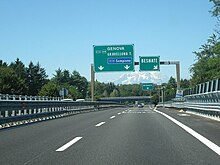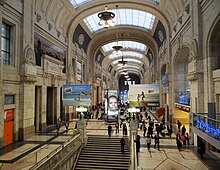
Back النقل في إيطاليا Arabic Transporte en Italia Spanish Transports en Italie French Promet Italije Croatian Olaszország közlekedése Hungarian Տրանսպորտն Իտալիայում Armenian Trasporti in Italia Italian イタリアの交通 Japanese Italijos transportas Lithuanian Транспорт в Италии Russian



Italy has a well developed transport infrastructure. The Italian rail network is extensive (16,723 km (10,391 mi)), especially in the north, and it includes a high-speed rail network that joins the major cities of Italy from Naples through northern cities such as Milan and Turin. The Florence–Rome high-speed railway was the first high-speed line opened in Europe when more than half of it opened in 1977. Italy has 2,507 people and 12.46 km2 per kilometer of rail track, giving Italy the world's 13th largest rail network.[5] The Italian rail network is operated by state-owned Ferrovie dello Stato, while the rail tracks and infrastructure are managed by Rete Ferroviaria Italiana.[6]
Italy's paved road network is also widespread, with a total length of about 487,700 km (303,000 mi).[7] It comprises both an extensive motorway network (7,016 km (4,360 mi)), mostly toll roads, and national and local roads. Italy was the first country in the world to build motorways, the so-called autostrade, reserved for fast traffic and for motor vehicles only.[1][2] The Autostrada dei Laghi ("Lakes Motorway"), the first built in the world, connecting Milan to Lake Como and Lake Maggiore, and now parts of the A8 and A9 motorways, was devised by Piero Puricelli and was inaugurated in 1924.[2] The Strade Statali is the Italian national network of state highways. The total length for this network is about 25,000 km (16,000 mi).[8] The routes of some state highways derive from ancient Roman roads, such as the Strada statale 7 Via Appia, which broadly follows the route of the Roman road of the same name.
Italy is the fifth in Europe by number of passengers by air transport, with about 148 million passengers or about 10% of the European total in 2011.[9] In 2012 there were 130 airports in Italy, including the two hubs of Malpensa International Airport in Milan and Leonardo da Vinci International Airport in Rome. Since October 2021, Italy's flag carrier airline is ITA Airways, which took over the brand, the IATA ticketing code, and many assets belonging to the former flag carrier Alitalia, after its bankruptcy.[10] The country also has regional airlines (such as Air Dolomiti), low-cost carriers, and Charter and leisure carriers (including Neos, Blue Panorama Airlines and Poste Air Cargo). Major Italian cargo operators are ITA Airways Cargo and Cargolux Italia.
Because of its long seacoast, Italy also has many harbors for the transportation of both goods and passengers. In 2004 there were 43 major seaports including the Port of Genoa, the country's largest and the third busiest by cargo tonnage in the Mediterranean Sea. Due to the increasing importance of the maritime Silk Road with its connections to Asia and East Africa, the Italian ports for Central and Eastern Europe have become important in recent years. In addition, the trade in goods is shifting from the European northern ports to the ports of the Mediterranean Sea due to the considerable time savings and environmental protection. In particular, the deep water port of Trieste in the northernmost part of the Mediterranean Sea is the target of Italian, Asian and European investments.[11][12] Transport networks in Italy are integrated into the Trans-European Transport Networks.
- ^ a b Lenarduzzi, Thea (30 January 2016). "The motorway that built Italy: Piero Puricelli's masterpiece". The Independent. Archived from the original on 26 May 2022. Retrieved 12 May 2022.
- ^ a b c "The "Milano-Laghi" by Piero Puricelli, the first motorway in the world". Archived from the original on 1 September 2021. Retrieved 10 May 2022.
- ^ "La Stazione Centrale di Milano: la più grande in Europa". Retrieved 1 October 2023.
- ^ "Special report: A European high-speed rail network". op.europa.eu. Retrieved 22 July 2023.
- ^ Compare List of countries by rail transport network size.
- ^ "Il trasporto ferroviario" (PDF) (in Italian). Archived (PDF) from the original on 13 October 2022. Retrieved 12 July 2022.
- ^ CIA World Factbook 2005
- ^ Cite error: The named reference
stradeanas.itwas invoked but never defined (see the help page). - ^ "Trasporto aereo in Italia (PDF)". ISTAT. 7 January 2013. Archived from the original on 13 January 2013. Retrieved 5 August 2013.
- ^ Buckley, Julia (18 October 2021). "Italy reveals its new national airline". CNN. Archived from the original on 18 October 2021. Retrieved 18 October 2021.
- ^ Marcus Hernig: Die Renaissance der Seidenstraße (2018) pp 112.
- ^ Bernhard Simon: Can The New Silk Road Compete With The Maritime Silk Road? in The Maritime Executive, 1 January 2020.
© MMXXIII Rich X Search. We shall prevail. All rights reserved. Rich X Search